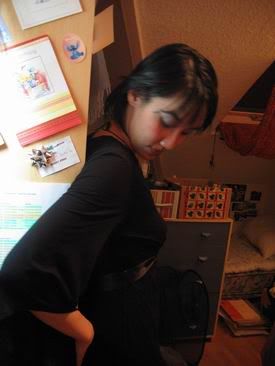
Let's start this by playing a game: Can you spot the emperor?
..........
..........
..........
..........
..........
Answer: His Highness is the one in green robe, sitting on the balcony. :-) His Highness is enjoying the autumn, relaxing at balcony and overlooking the river.
... and this is just one of the twelve pieces of hanging scroll, among many other paintings and displays in the exhibition. Besides this set of twelve, there are many other giant scrolls paintings with careful details and interesting depict of the life of the emperors in the Qing Dynasty.
Yes, you got it right. It is the Royal Academy of Arts' exhibition 'China: The Three Emperors, 1662–1795'. Yipee~!!! It is right in London, barely 5 minutes walk from the Picaddily Circus tube station! Having been visiting various exhibitions (always in London, muahaha...), I didn't lose time to try out this one. And the trip was worthwhile!
Focusing on the Qing Dynasty, during the reign of the three greatest emperors, this exhibition presented about 400 pieces of treasures (robes, paintings, furniture, antique, throne, scientific instruments, cultural pieces, etc...); in fact, many of these treasures have not been exhibited outside China before. The main theme of the exihibition revolves around the various perspectives of the Qing dynasty - its empire, culture, rituals and religions, palace life, scientific progress, international relations, literature, and lifestyle. The feature of this exhibition that attracted me the most is the way they presented these knowledege; stories are told not through words, but through scrolls and scrolls of paintings by anonymous court artists, displays of the furniture, instruments and items used at the era.

Meet Kang Xi, the legendary emperor who started his 'emperor-ship' (is there SUCH a word, i wonder?) at a very young age. This potrait of him in a court dress will be familiar for those who read the famous novelist Er Yue He, who has written novels on these three emperors. (Great books, a must read) He used these paintings of the emperors as the book covers. :-)
An interesting thing is, even though these emperors are Manchurian people, they wear this formal court dress in Chinese style, a tactic of assimilation into the system of the previous dynasties.
We found it fascinating to observe the very detailedly-done paintings on supersize scrolls, and soon developed an amusing game which helped ourselves remembering more vividly about the exihibited pieces - "Spot the Emperor". The paintings were done with such details that they painted every single man, and even animals, very carefully, regardless of their ranks. It is hard to spot the emperor sometimes, because there is no significant emphasis on his figure. We would have to observe the rituals and customs carefully to be able to guess which one is him. :-) and guess what, sometimes the artists are so mischiveous that they inserted some little "mythical" small animals (from our deduction: a mixture of dragon, dog, and some other animals) among the crowd. What a discovery!
Another interesting fact is the parallel practice of Shamanism (pagan religion) and Buddhism during the Qing Dynasty. Most of the Qing emperors embraced Buddhism, and Yongzheng was famously noted with his avidness in Chan Buddhism, while Qianlong with his Tibetan Buddhism. Other religions - Taoism, Christianity and Islam were also tolerated. For Shamanism, there was an exhibit of the instruments used on the altar of Moon, where the seasonal rituals of offerings were made.

Of course, Manchurians are fearless warriors, good hunters and skillful riders. This painting shows Qianlong in his armour, on his horse. In their culture, Kangxi and Qianlong went on long journeys north for ceremonial hunting in many years of their reigns. Several of the paintings in the room illustrated aspects of these hunting expeditions. To reinforce their authority in their Chinese territories, the Kangxi and Qianlong Emperors also undertook journeys through the south of China, particularly the Yangtze region. There are stories about the emperors dressing up as normal people, sneaking out to the streets to assess the "Real" lifestyle of the people, instead of the glamourous show put up by the officials during their inspection trips. This is to see the real situation to make better judgement and decisions on policies and governing the country. Based on these 'stories', many drama series have been made, and some are being re-made, to tell the glory days of Qing.
There were many other display pieces on the foreign diplomatic gifts, scientific knowledge sharing and extraordinary foreign instruments. Also, a large collection of the art paintings, carvings, calligraphy, etc were on displaying, again showing the richness of the dynasty, and the pursuit for beauty in art. A common trait among these grandad-dad-son emperors are their zeal in collecting art pieces, and indulgence in literature and art. :-)
Oh ya... before I forget, here is a picture of YongZheng, dressed in Taoism robe.

There are many other pictures depicting him as many roles - warrior, Buddhist monk, and even wearing the European court wig! We were smiling widely when looking through these paintings, the emperors sure do have a good sense of humour to be potrayed as different characters!
Well, I must say, it is fruitful to have gone for this exhibition. It was fun and informative. And somehow, via such approach to potray the emperors, it brings the emperors so much closer to layman like us - they enjoy things, they learn and they live life well, and they sure do have their crazy sides too! :-P
Let's end with the sandalwood seal of Kang Xi, marking the end of this post. The site www.threeemperors.org.uk shows a nice introduction and some information. Do have a look there as well.
(Note: I have not written here a lot of history of the dynasties, there are too many interesting things to write! I would suggest a good research and study on the history, because it would be wonderful to savour the many layers of the colourful history...)

